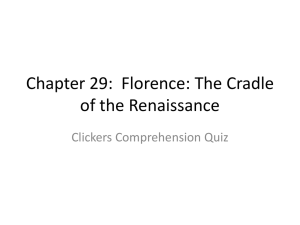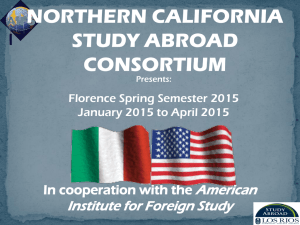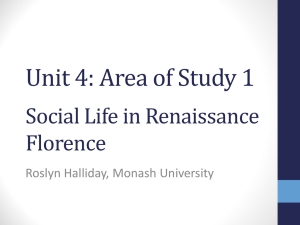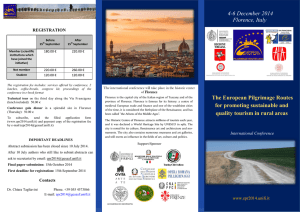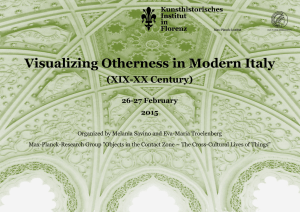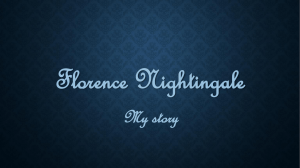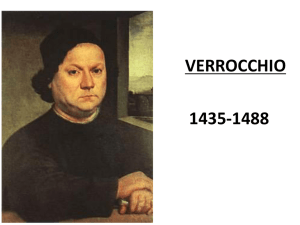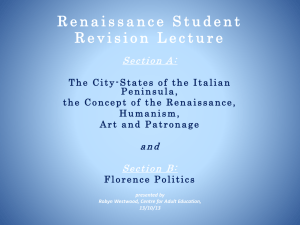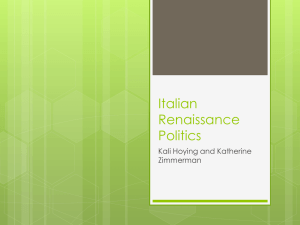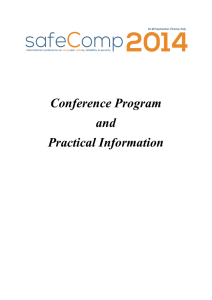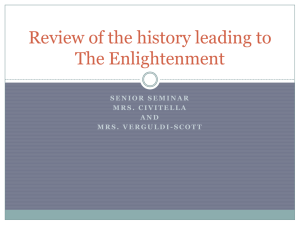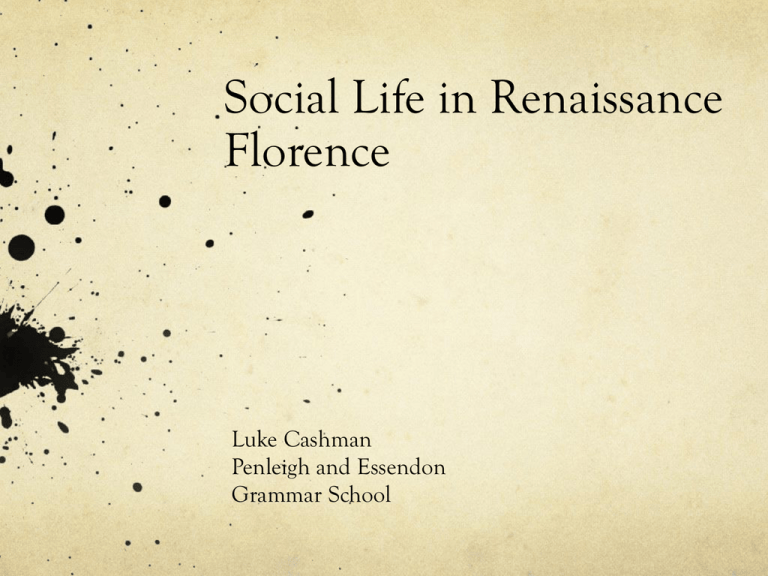
Social Life in Renaissance
Florence
Luke Cashman
Penleigh and Essendon
Grammar School
What we will be doing today…
Decipher key phrases from the Study Design
Explore the city of Renaissance Florence
Discuss the essence of social history
Review the sources available for this AOS
Open up essay topics from the VCAA exams
Propose possible response structures
Examine primary and secondary source evidence
Consider the historiographical debates
The VCAA Study Design
Social structures shaped by economic and political bases
Social hierarchy reflected in dress, housing, food, entertainment and the social map
In my own crude definition, the “social map” is a combination of who you were, where
you lived and who you knew
Historical debate over how important gonfalone (sixteen administrative districts) were to
political, economic, social and religious aspects of life at the time
Range of relationships crucial to a Florentine’s ability to survive and thrive
Relationships described as competitive, pragmatic or co-operative, but rarely personal
(but can this view be challenged?)
Functional views shaped by evidence such as strategic location of families within
neighbourhoods, marriage contracts and dowries, and the institutionalisation of charity
Those outside of the networks established by the dominant elite and the ambitious:
urban poor, foreigners, ‘deviants’
Various means, such as legislation, charity and festivals were used to incorporate these
groups into the life of the city in the interests of civic harmony
Investigate the nature and roll of social conventions and relationships based on location,
wealth, gender, class, or inclusion within or exclusion from the city’s mores
The challenge posed by Unit 4, AOS 1
The most challenging section of this subject but, potentially, also the most rewarding
Not the standard “History”:
“History is past politics.” (Sir John Seely, Professor of Modern History at Cambridge in
the late C19th)
“The point of History is to study people who mattered and the workers, the peasants,
collectively, had hardly ever mattered, so a historian rarely had to take notice of them.”
(John Brooke, University of Manchester, mid C20th)
Thomas Carlyle (1795 – 1881): “The History of the world is but the biography of great
men.”
Reduces History to the study of kings, diplomats and generals
The emergence of social history in the 1950s (employing methodologies used in the
social sciences [eg demography], economics, statistics and anthropology)
More than “history with the politics left out” (G.M. Trevelyan, English Social History,
1944)
An attempt “to adopt the perspective of ordinary men and women in the past, to write
about their experiences and to look on the state, politics and society with their eyes”
(Evans, p165) so that we can rescue them “from the condescension of posterity”. (E.P.
Thompson, p12)
A broad focus: the body; medicine and disease; popular culture, festivals ad folk-lore;
religious practices; crime and punishment; sexuality and madness; the family;
neighbourhoods and friends; clubs and confraternities, work and leisure; the use of
private and public spaces
Our sources
for Social Life in Renaissance Florence
Firstly:
The Catasto (Italian for ‘to pile’ or ‘stack up’)
“The first detailed tax assessment of every citizen of a city anywhere.” (Eckstein,
The District of the Green Dragon, p44)
Demanded of all inhabitants a list of assets, debts, credits, financial obligations,
family members and their ages, so it constitutes a census as well.
First instituted in 1427 and intermittently abolished and reinstated until 1480.
Brought in to raise funds after a disastrous war with Lucca in the 1420s and to
replace the arbitrary prestanza, whereby the Commune determined how much
money was needed and divided this evenly amongst the sixteen gonfalone. Officials
in these districts then determined how the money was going to be collected, who
was going to pay, and who would be deemed exempt. Therefore, the officials of
your gonfalone were good men to know.
Secondly:
The memoirs (Ricordi) of Florentine merchants; guidebooks or survival manuals
for their sons in the event of the father’s untimely death (a likely circumstance
given the persistence of the plague in late C14th and C15th).
Giovanni Morelli: “without a guide or leader”
Thirdly:
Contemporary images of the city, and the extant city itself!
The Chain Map, attributed to Francesco di Lorenzo Rosselli (1470)
Nineteenth-century copy of the chain map:
Explore a 3D map:
http://arkaround.wordpress.com/2011/02/19/3d-recontruction-ofveduta-della-catena-florence/
The Bounsignori Map of 1584, dedicated to Grand Duke Francesco Medici
http://cds.library.brown.edu/projects/florentine_gazetteer/
The five basic essay types
1.
How important was the social system in the lives of Renaissance
Florentines?
2.
To what extent were social relationships motivated by the desire for
honour/reputation/a good name?
3.
What was the essence of a Florentine’s identity?
4.
To what extent was Renaissance Florence a cooperative or competitive
society?
5.
To what extent did Florence include or exclude non-elite members of
society from public/civic discourse?
Key bit of advice: ideas and evidence from your research and reading
can be used in most, or all, of the essay topics. You don’t have to
reinvent the wheel
1. The importance of the social system
An individual was entwined from birth to death in a network of
overlapping circles of personal associates, beginning with kinsmen
and extending outward to include relatives by marriage,
neighbours, and friends, whom his honor bound him to assist and
promte in all their endeavours. (Dale Kent, Friendship, Love, and
Trust in Renaissance Florence, p2)
Networking in Renaissance Florence was fraught with danger and,
potentially, ruinous:
Alberti: “Everything in the world is profoundly unsure.”
Morelli: “Test your friend a hundred times… before you trust
him, and do not trust him to such as extent that he can be the
cause of your undoing.”
Why was active participation in the social system so important?
Three broad reasons:
a.
b.
c.
The benefits it conferred (political & financial)
Self-preservation and protection
Spiritual fulfillment and psychological release
a. The benefits of the social system
Highly valued commodities (wealth, property, political office, honour) were
finite, hence competition for a greater share of the spoils offered by the city on
the Arno River was fierce. So, how did one make their way in this treacherous
world?
“The more extended one’s network, the greater were one’s chances of worldly
success.” (Weissman, p28)
Alberti: “Fortunate and affluent men are indeed extremely useful friends, not
so much because they will help you with their wealth and power, but
because… they can show you the way to acquaintance with all lesser and
ordinary persons.”
What could the network provide for you?
Access to the networks of others
News of work and investment opportunities, properties available for purchase or
rent, sources of credit, incoming goods, foreign exchange rates, market conditions
Prized commodities (Mazzei: “If any salted anchovies come to Pisa this year, I
would enjoy having a small barrel.”)
Political nomination and support in the gonfaloni, particularly during periods of
scrutiny
Membership in the various guilds through letters of recommendation
Through guilds and confraternities, means of patronising works of art and
architecture
b. Self-preservation and protection
To avoid a crippling tax burden:
The prestanza: a form of taxation which each gonfalone owed the city
treasury a set amount
Tax officials in each gonfalone, called sgravatori, determined how much
each individual would contribute
Tax assessments could be used as a weapon to destroy rival families and
clients, and a shield to protect one’s own
In 1443, Francesco Soderini, and member of the anti-Medicean group,
was crippled with an enormous tax debt
Francesco Datini described the gonfalone of the Red Lion, where he has
business interests, as a “rapacious beast”.
Giovanni Morelli was forced to move gonfalone: “And we did this because
of the forced loans, that is, to get out of the Black Lion.”
Morelli advised his sons to live frugally. Lavish & extravagant spending
will only cause you to “be defamed as a very rich man, and on the basis
of such rumours they will hit you really heavily with taxes.”
Giovanni Rucellai: “I have always remained on good terms with my
relatives and neighbours and the other residents of the district, so that
whenever the taxes have been assessed, they have befriended me and
taken pity on me.”
A safety net : “Most social services were voluntary and private. In
time of need one relied on the aid and charity of friends and
kinsmen.” (Weissman, p28)
A Florentine explains to the tax collector: “I find myself living in
the house of Francesco di Piero Marchi, and I do not pay any rent,
because I am poor and [I am] his brother-in-law.”
Lapo Niccolini: “His house was on several occasions saturated by
an influx of close relatives who were widowed or in need owing to
the plague. As head of casa, Niccolini, Lapo opened his doors
wide to those relatives in difficulty… To belong to the same casa
also meant to be able to take refuge or to gather under the same
roof when danger threatened.” (Klapisch-Zuber, pp73 – 4)
Lapo Niccolini took in sisters, aunts, granddaughters, nieces and
cousins
c. Spiritual comfort and psychological release
Confraternities:
Voluntary associations of lay men and women; very low entrance fees so that
“anyone in the city who could afford the very modest subscription fee… would
have belonged to such a group.” (Eckstein, Saint Agnes, San Frediano and Friends,
1991)
Worship, organise charity, carry out penitential practices (such as self-flagellation),
patronise artworks
Could ease guilt of usury
Vespasiano da Bisticci on Cosimo de Medici: “Although I can’t say where it came
from, his conscience pricked him about some money which he had come by not
quite cleanly.”
Family & friends:
The family palazzo or casa “provided some relaxation from the tensions of the
piazza.” (Weissman, p32)
Friendships (like that between Datini & Mazzei) provided the opportunity to
express emotions and sentiments too risky for the piazza
“[Friendship] was not primarily about personal feeling; its purpose was the pursuit
of mutual honor and profit. The essential themes of patronage letters were the
responsibilities, rights, and benefits inherent in the obligations of instrumental
friendshps. However, once these were established, they constituted a framework of
trust within which personal feeling might safely flourish.” (D. Kent, Friendship, Love
and Trust, p59)
At night Mazzei placed Datini’s letters on his nightstand among his “dear things”
(Trexler, p136); Mazzei felt that he and Datini were “two persons in a single soul.”
(D. Kent, Friendship, Love and Trust, p65)
2. The importance of honour in mediating
social relations
Synonyms for honour: a good name; reputation; status; esteem;
regard
The concept of honour was composed of:
Wealth
Political office
An ancient lineage
A dense network of friends, patrons & clients
An ability and willingness to meet one’s obligations (helping
clients and patrons)
Religious devotion (through patronage and charity)
Avoiding potentially ruinous gossip and “losing face” at all costs
Guicciardini: “You can see at every turn the benefits of having a
good name, a good reputation… a good name is worth more than
great riches.” (Weissman, p25)
The desire for honour significantly mediated relationships between kin,
friends and neighbours
All contacts would be used to increase one’s share of the commodities
(physical & abstract) that constituted honour
Many relationships were, therefore, utilitarian or instrumental. To a
significant extent, social relationships revolved around what you could get out
of them for yourself (recall Mazzei’s request for anchovies to Datini)
Morelli: “Contrive to acquire one friend or more in your gonfalone and if there
is anyone who will serve to thrust you forward, attach yourself to him.” (D &
F Kent, Neighbours and Neighbourhood in Renaissance Florence, p52)
Honour could override deeply entrenched links of loyalty. Giovanni Rucellai:
“It makes no sense to destroy one’s own fortune in order to save that of a
relative.”
Personal honour versus family honour: the Lanfredini case (see Kuehn, Family,
Law & Women).
The accumulation of honour was a self-perpetuating cycle: the more one
attained (through the accumulation of wealth, political offices & contacts),
the more he was likely to receive. The inverse, of course, was also true!
However, honour was not always the primary
motivating factor in relationships in Renaissance
Florence:
While belonging to a confraternity allowed one to
publically demonstrate the piety and generosity (and
were also a great place to network) there was a spiritual
need that these organisations fulfilled
Similarly, friendships, while being at least partly
utilitarian, were an important place where one could,
theoretically, lower one’s guard and trust another
completely
The case of Lapo Niccolini also demonstrates that
family ties, which necessitated taking in members of the
non-immediate family, could be stronger than the
pursuit of profit
3. What was the essence of a Florentine’s
identity?
In the corporate world of Renaissance Florence, individuals typically
defined their identity in relation to collectives (parenti, vicini and amici)
Neri di Bicci described himself in the first page of his account book as
‘a painter, from the parish of San Friano, the district of Drago and the
quarter of Santo Spirito’.
Class or geography
Neighbours (vicini)
Family (kinship – parenti)
Friends (amici)
Opportunity for historiographical debate of which
element was the most important
Class or geography?
Historiographical debate: Was Renaissance Florence riven by class rivalries
that turned rich and poor into mortal enemies that flared up periodically in
episodes like the Ciompi Revolt of 1378?
In essence, was there a “class-consciousness” in trecento and quattrocento
Florence?
Guildsmen (7 major and 14 minor) held both the economic and political
reins of the city.
Economic status revealed by the Catasto of 1427:
17% of Florentine households headed by major guildsmen
45% headed by minor guildsmen
38% sottoposti and ciompi (Weissman, p3)
In the district of the Green Dragon, about 33% of households (97 in total) were
deemed miserabili, or too poor to pay taxes (Eckstein, The District of the Green
Dragon, p46)
Weissman: “The spatial distribution of the popolo minuto did change over the
course of the fifteenth century, as they left the central city area, and came to
be relatively segregated in the peripheral parishes of the city.” (p10)
Nevertheless, the Ciompi Revolt was a one-off (“The Quattrocento was
remarkable… for the absence of Ciompi-like revolt”, F.W. Kent, Be Loved
Rather than Feared, pp28 – 9)
Two possible reasons:
1.
2.
Harsh repression
Effective integration of the ciompi and sottoposti into the political, social and
economic life of the city
Integration facilitated by the ‘social map’ of the city
“A remarkable feature of Renaissance Florence was the social and economic
heterogeneity of each district and neighbourhood. No sections of the city were
reserved exclusively for the rich, no ghettoes inhabited solely by the poor.
Each district was a mélange of palace and cottage, of cloth factory and retail
shop, of parish church and monastic foundation.” (Brucker, Renaissance
Florence, p23)
“The lives of the citizens of the Red Lion, rich and poor, powerful and
humble, intersected.” (F.W. Kent, Ties of Neighbourhood and Patronage in
Quattrocento Florence, pp85)
The rich bought goods at local shops and paid for services from local artisans
and labourers; the poor rented shop and home spaces from the rich.
Vicini (neighbours in the parish, gonfaloni, quarter)
After the expulsion of Walter of Brienne in 1343, the six districts (sesti) of Florence were abolished and
replaced by four quarters. Each quarter was divided again into for gonfaloni (or banners). Based on the
sixteen militia companies of the city – hence the name. The head of the gonfalone, elected for a twomonth term, was the gonfaloniere (standard-bearer). Abolished by the Medici in 1531 (F.W. Kent, Ties of
Neighbourhood and Patronage in Quattrocento Florence, p90)
These districts played a crucial role in the administrative life of the city:
Taxation determined in the gonfalone
The electoral process began in the gonfalone
News about business opportunities, cheap credit, property for sale, legal advice, suitable marraiges
Election to the Signoria was determined at the level of the quarter
“Neighbours remained immensely influential in a man’s life, and it was essential to win the approval—
by marriage, business alliance or acts of friendship—of the more powerful figures in one’s gonfalone.”
(F.W. Kent, Ties of Neighbourhood and Patronage in Quattrocento Florence, pp83 – 4)
Giovanni Morelli: “Do your best to forge a marriage alliance and to acquire a relative who will be a
father to you… look first in your own gonfalone, and if you can make a marriage there, you should be
readier to do so there than elsewhere.”
“The Florentine’s sense of neighbourhood varied according to his class, his status, and his sense of the
utility of local bonds in the attainment of specific objectives.” (Weissman, p19)
Essentially, the higher up the social scale one was, the broader their social horizon:
The poor – the parish church and its piazza
Guildsmen – the gonfalone and the quarter (Lapo Niccolini sought a marriage alliance from the quarter
of the Spirito Santo)
The patricians/elite – the entire city and, possibly, beyond
Parenti
Strong link between geography and family: “Family houses clustered together in the same
parish, or in contiguous ones” and “In the 1480 Florentine Catasto reveals extensive
clustering of households sharing the same name within the gonfalone. (Weissman, pp10
& 13)
“The family was the basic unit and the blood tie was the most powerful cohesive agent.
The obligations of kinship invariably commanded a higher priority than did the rival
claims of state or church.” (Brucker, The Society of Renaissance Florence, p28)
Trexler: A Florentine was “either a member of family… or nothing at all.”
Family members were also business partners; they could, theoretically, be trusted with
information that, in the hands of a rival, could be financially ruinous.
Alberti: “There is more honour and value in helping your own family than outsiders… a
stranger abides with you as an enemy, while a kinsman is always our friend” (Weissman,
p27)
Lapo Niccolini taking in his numerous relatives. Also turned to extended family (uncles,
cousins etc) to deal with delicate family matters (inheritance disputes etc)
When families dissolved, as with the Lanfredini family, the results could be personally
catastrophic (“the complete and violent estrangement between Remigio and
Lanfredino”, Kuehn, Law, Family & Women, p129)
Amici
The obligations imposed by family could be suffocating, as
Lapo Niccolini discovered. Friendships, then were an outlet
of some intimacy yet reduced obligation
Paolo da Certaldo: “A man without a friend is like a body
without a soul” and “a man who loses his friends is worse
than dead.”
Met the social, political and economic needs of Florentine
citizens (access to the social network, political office,
business opportunities and tax relief)
Also the psychological need (see for example the emotional
sentiments in the letters of Datini and Mazzei)
4. Cooperative or competitive?
Weismann: “The Florentine observed that society contained a
limited quantity of honours and riches.” (p27)
With precious political offices and tax relief up for grabs,
competition and conflict was practically inevitable. Weismann: “It
was expected that strangers would employ their resources to ensure
one’s downfall, if only given the chance.” (p27)
Florentines were competing for more than their fair share but, as
we have seen, also needed each other in their quest for honour
Weissman uses the term “agonistic” to describe this paradoxical
social circumstance; that is, competitive and supportive
encounters between individuals seeking essentially the same goal
and outcome
Can be explored through parenti, vicini and amici
Parenti
“The Florentine’s home was an unsure refuge from constant
scrutiny.” (Weissman, p34)
Suffocating, claustrophobic sense of obligation; shared
responsibility for maintaining the family’s honour
Lapo Niccolini:
Disappointment with his sons’ failure to marry and move out
of the family casa
Lending money to relatives, only to not have it paid back
The Lanfredini family:
An example of a Florentine family in meltdown; clash
between father and son over a matter of familial honour son
leads to the son abandoning the family for Venice
Thomas Kuehn, Law, Family and Women, Chicago: University
of Chicago Press, 1991.
Vicini and amici
Absolutely vital in securing business opportunities, political office and tax relief
Ser Lapo Mazzei acted as Datini’s “contact” in Florence. As a notary, Mazzei was familiar
with the business dealings of many wealthy and powerful men and was familiar with the
inner workings of government. He was, as Trexler notes, “a good man to know.” (Trexler,
The Friendship of Citizens, p134)
Advice from the Ricordi warning against false friends and opportunities for betrayal. For
example, Giovanni Rucellai advised his sons that the best way to defend their fortunes
was to avoid making enemies, since “one enemy can do more harm than four friends can
do to help.” (D. Kent, Friendship, Love and Trust, p63)
Marco Parenti and his neighbour Bernardo Rinieri went to court in 1472 over Rinieri’s
terrace that allowed rain water to gush into Parenti’s roof. In 1487 Parenti hit back by
putting a window in his wall, thereby ruining Rinieri’s privacy. (F.W. Kent, Ties of
Neighbourhood and Patronage in Quattrocento Florence, p88)
Tensions between Mazzei and Datini: “The fact remains that I’m a friend and not a
friend.” (Trexler, pp152 – 3)
Clashed over Datini’s ingratitude and disregard for Mazzei’s assistance and advice
Mazzei’s preferential treatment of other friends and patrons
Mazzei feared being seen as merely a client of Datini rather than a friend (which implied
notions of greater equality and intimacy)
Confraternities
Still a chance to enhance one’s esteem in the eyes of others
through donations to charitable works and collective patronage of
religious artworks
As membership was generally open to all, confraternities were also
an opportunity to network with social ‘superiors’ (for example,
Both Cosimo and Lorenzo were members of the confraternity of
Sant’ Agnese in the gonfalone of the Drago Verde).
Most drew their memberships from the whole city, so encouraged
a Florentine consciousness
Engaged in work that the late-medieval state could not provide:
bread distribution, dowry funds, affordable rent, burying the dead
(particularly important in times of the plague)
Such important civic duties were also pleasing to God (Eckstein),
so no distinction was made between being a good citizen and
being a good Christian
5. Insiders & Outsiders
Limits on social inclusion: male; wealthy; guild member;
Christian
Outsiders:
Urban workers
Women
Jewish people
Those engaged in homosexual acts
Nevertheless, these groups fulfilled important functions in
the social and economic life of the city and could not be
entirely excluded. Legislation, civic ritual and social custom
regulated the degree, however limited, to which they could
participate in the public life of the city along with their elite
neighbours.
Urban workers
As non-guild members, excluded from active participation in the governance of the city
Two periods of expansion of suffrage (1340s and 1370s) quickly extinguished by guildelite
“The dramatic events of the Ciompi years were long remembered precisely because their
descendants remained a numerous and active force to be reckoned with.” (F.W. Kent, Be
Rather Loved than Feared, p28)
Urban workers drawn into the patron-client system (goods, services, rental properties etc)
Charitable works (bread distributions, dowry funds & cheap rent) designed to satisfy the
most urgent grievances and “encourage peaceful co-existence between [the patricians]
and the popolo minuto” (F.W. Kent, Be Rather Loved than Feared, p31)
Open membership of confraternities provided leadership opportunities for those not
matriculated in one of the guilds (see Eckstein, Saint Agnes, San Frediano and Friends)
Witnessed spectacles such as festivals, pageants, feasts and tournaments (particularly the
Feast Day of St. John the Baptist, patron saint of the city, on 24 June)
“No city had more spectacular nor more numerous public entertainments.” (Hibbert,
The Rise and Fall of the House of Medici, p119) No more than 275 working days a year.
Could be used to distract workers from their drudgery and give them something to look
forward to.
Women
Jakob Burckhardt: “women were on a footing of perfect equality with men” (in Natalie Thomas, A
Positive Novelty: Women and Public Life in Renaissance Florence, p4)
Women were considered ‘legal minors’, so excluded from the business and political world of the city
Could join confraternities but not be appointed to positions of leadership within them
Generally passive onlookers during civic festivals and processions
In Della Famiglio, Alberti argued that women should be ‘locked up at home’. (Thomas, p8) A woman’s
honour was a function of her obedience and chastity. (Weissman, p26)
Florentine families were patrilineal and patrilocal. Women who married into a family lived in their
husband’s house. Never really part of the family, hence could not be trusted “as they were a potential
source of gossip about family affairs.” (Weissman, p33)
Seen as temporary, if long-term, interlopers. Lapo Niccolini counted the number of days that his
mother stayed at the Niccolini casa (67 years, 2 months, 26 days); (Klapisch-Zuber, p74)
Thomas argues that this potentially weak position (caught between two worlds) was also a potential
advantage. Brought new connections to the family through marriage and brought with them a dowry
to support their new family’s business endeavours (p8)
If their husband died, women could return to their blood-family with their dowry. However, any
offspring from the marriage remained with the deceased husband’s family. (Klapisch-Zuber, p74)
A prostitute was forced to wear “gloves on her hands and a bell on her head.” (Brucker, The Society of
Renaissance Florence, p191) Three communal brothels established by 1415 “in suitable places where the
exercise of such scandalous activity can best be concealed.
Jewish people
As outsiders, Jews could not participate in the political and social life of the city. Tended to live in
small enclaves in the city, inter-marry, seek Hebrew scholars to educate their children. (Banker, Lay
Male Identity in a Tuscan Town, pp333 – 4 )
“Religious differences were the main obstacles to assimilation.” (Brucker, The Society of Renaissance
Florence, p240) In a law of 1430, Jews were described this way: “Considering that Jews or Hebrews are
enemies of cross, of our Lord Jesus Christ and of all Christians…” (Brucker, p240)
In 1434, Guglielmo Dattali, and Florentine Jew, “had carnal relations with Masina, a Christian
woman… to the shame and degradation of the Christian religion, in contempt of the Catholic faith.”
[he was fined 500 florins in absentia] (Brucker, p244)
Nevertheless, as Brucker notes, for a late medieval city, “Florence was a remarkably tolerant
community.” In a law of 1463, Jews were permitted “to perform and recite the ceremonies and offices
in the synagogues and houses in which they live…” (Brucker, pp240 & 3)
Jews performed a vital economic function in this capitalist city-state. Communal legislation on Jews
(1430) declared: “desiring to admit Jews into the city, the lord priors… may authorise any Jew to engage
in usury in the city of Florence.” However, the rate of interest could not exceed 20% per year.
(Brucker, p241)
Regulation of the Jewish community (1463): “To prevent any large concentration of Jews in Florence,
or a greater number than is necessary, in future the Jews engaged in money lending in Florence may
not number [count[ more than seventy persons in their houses and in their shops, working as factors
or apprentices… And if this number be exceeded… the [Jewish] community will be fined 50 florins for
each person and for each violation.” (Brucker, pp242 – 3)
“Every Jew, male or female above the age of twelve… shall be required to wear a sign of O in the city of
Florence… A penalty of 25 lire shall be levied on every occasion that this sign is not worn.” (Brucker,
pp241 – 2)
Homosexual activity
No ‘homosexuals’ in Renaissance Europe as we understand the term (those who sexually
engage exclusively with people of their own gender and that this forms an important part of
their identity)
Sodomy was generally taken to mean the act of sex between two men, but it could also be
extended to sexual acts between men and women. Sodomy was seen as both contrary to nature,
as it could produce no children, and also sinful.
Typically, older men took the ‘active role’ while adolescent boys were the ‘passive’ participant;
cut across class distinctions. Those engaged in acts of sodomy came from every social level in
the city
“For most, [sodomy was] an occasional or temporary transgression that did not preclude sex
with women either concurrently or during other periods of their lives.” (Rocke, Forbidden
Friendships, p15)
Could also be used as a political weapon: convictions peaked in 1435 (the year after Cosimo’s
return from exile – those convicted tended to be from the Albizzi faction) and the first five
years of Lorenzo’s ascendancy. (Najemy, A History of Florence, p249)
Florence had a Europe-wide reputation for sodomy. The prevalence of sodomy in Renaissance
Florence: “During [the Office of the Night’s] seventy year tenure from 1432 to 1502… in this
small city of around only 40,000 inhabitants… as many as 17,000 individuals or more were
incriminated at least once for sodomy, with close to 3,000 convicted.” (Rocke, Forbidden
Friendships, p4)
Possible reasons for prevalence:
The relatively late age of marriage for Florentine men (around 30 years old)
The lack of opportunities for casual sex with women (cloistering and nunneries)
Formed part of the network of alliances and friendships that strengthened bonds and fostered business contacts between
patrons and clients
Legislation (see Brucker, The Society of Renaissance Florence):
1415: “Desiring to eliminate a worse evil [sodomy] by means of a lesser
one [prostitution], the lord priors… authorise the establishment of two
public brothels in the city of Florence, in addition to the one that
already exists.”
1418: Electoral officials were instructed by the priors to exclude anyone
from eligibility for political office if they “been suspected of that crime
[sodomy].”
1432: The Office of the Night was established “to discover who commits
the vice of sodomy”. As Rocke notes, this magistracy “was probably the
first and certainly one of the few criminal institutions with this specific
competency in the history of Europe.” (p4)
Seventeen reforms to penalties prescribed for sodomy between 1432 and
1542 (Rocke, p7)
The gap between rhetoric and reality:
In spite of the legislation (Intent of the Office of the Night was probably
to keep the practice of sodomy within acceptable bounds (Rocke, p226)
The officials, all patricians, were often judging men of their own status,
so were probably reluctant to proceed with harsh penalties
Fines were rarely paid in full or at all (Rocke, p80)
Harshest penalties, including execution, were typically reserved for nonconsensual sex or sex with male children
Dramatis Personae
Leon Battista Alberti (1404 – 1472): Humanist, author, artist, architect and
more
Paolo da Certaldo (c.1320 – c.1370): Florentine merchant and writer
Francesco Datini (1335 – 1410): wealthy merchant from Prato, outside of
Florence
Francesco Guicciardini (1483 - 1540): Florentine historian and statesmen
Lanfredino Lanfredini (late-C14th – mid-C15th): Son of Remigio Lanfredini
Ser Lapo Mazzei (late-C14th – mid-C15th): a notary in Florence
Giovanni Morelli (mid-C14th – early-C15th): Florentine merchant
Lapo Niccolini (late-C14th – mid-C15th): a prominent silk merchant
Giovanni Rucellai (1403 - 1481): wealthy Florentine wool merchant

